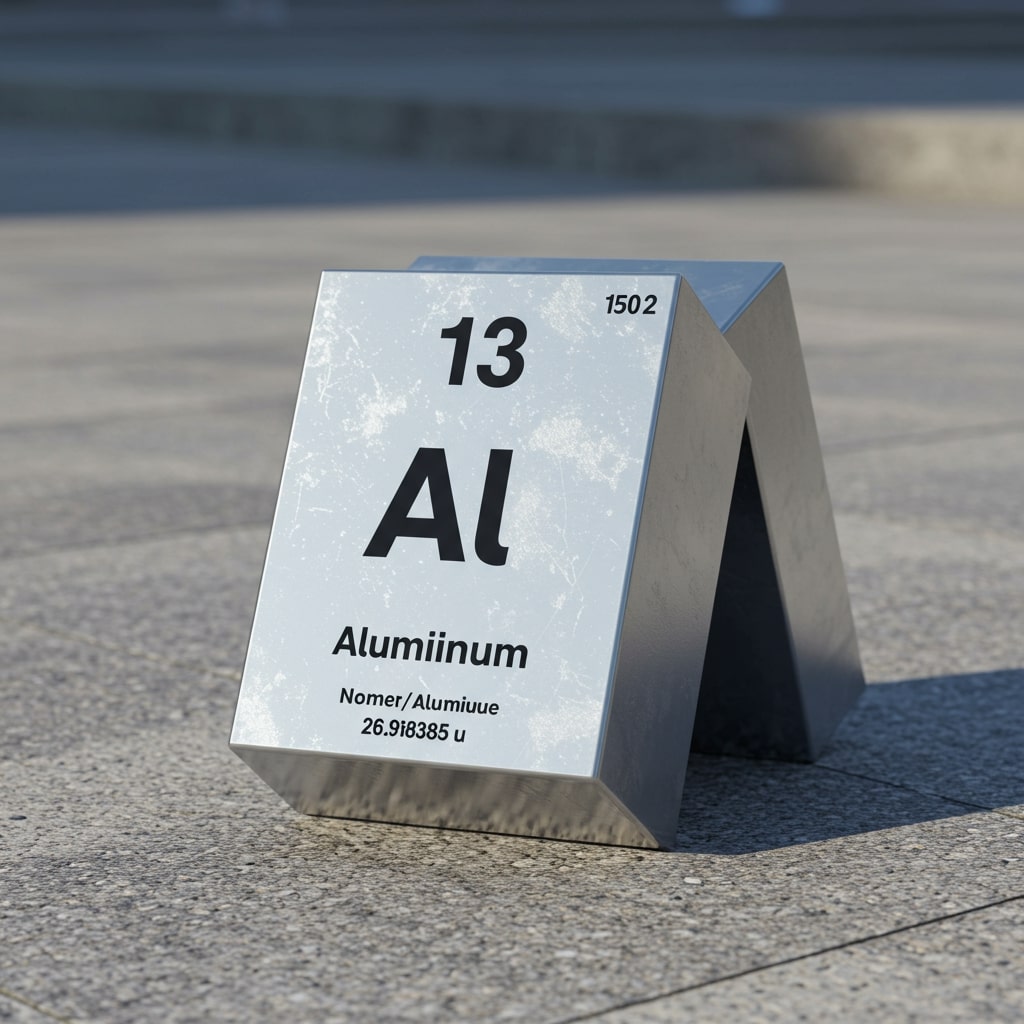
When you unwrap a sandwich from foil or gaze at the sleek body of an airplane, have you ever wondered, "Is aluminum a metal?" This question pops up more often than you might expect, especially since aluminum is everywhere in our daily lives—from soda cans and smartphones to cars and skyscrapers. But what truly defines a metal, and does aluminum fit the bill?
Let’s start with the basics: aluminum is indeed a metal. Scientifically, it belongs to main Group 13 of the periodic table and is classified as a lightweight, silvery-white metal. In fact, it’s the most abundant metallic element in Earth’s crust, making up about 8% by weight (Britannica). Its unique combination of properties has made it one of the most widely used metals in the world.
Why is aluminum so significant? Imagine a material that is lightweight yet strong, resists corrosion, and can be shaped into thin foil or robust beams. That’s aluminum in action—powering everything from aircraft and automobiles to window frames and beverage cans (Aluminum Association).
In this guide, we’ll answer the core question—"is aluminum a metal?"—and go much further. You’ll discover:
Sounds complex? Don’t worry—we’ll break down each topic in clear, straightforward terms, using real-world examples and easy-to-follow comparisons. By the end, you’ll have a complete understanding of why aluminum a metal is more than just a simple label; it’s a key to innovation in modern technology and industry.

If you’ve ever wondered, "Is aluminum a metal?"—you’re not alone. The answer is a resounding yes, but understanding why means looking at what truly defines a metal. Let’s break it down into simple, practical terms and see how aluminum checks every box.
Scientists classify a material as a metal based on several key traits. Here are the main criteria:
According to Britannica, these characteristics set metals apart from other classes of elements.
Let’s see how aluminum stacks up against each of these defining features:
On top of these, aluminum is also abundant and easy to shape, which further cements its status as a true metal.
It’s a common question: "Is aluminum foil a metal?" The answer is yes. Aluminum foil is made by rolling pure aluminum into an extremely thin sheet. Despite its flexibility and delicate feel, it retains all the properties of the metal—conducting electricity and heat, resisting corrosion, and maintaining its metallic sheen. So, every time you wrap leftovers in foil, you’re using a real metal product (Britannica).
Understanding that aluminum is a metal helps explain its wide range of uses—from aircraft frames to beverage cans and kitchen foil. Its unique blend of strength, lightness, and workability is only possible because it meets the scientific definition of a metal in every way.
Next, we’ll see how aluminum compares to nonmetals and metalloids, and why it’s firmly placed in the metal category on the periodic table.
When you look at the periodic table, you’ll notice a zigzag or “stair-step” line that divides metals from nonmetals. But what about the elements that border this line—are they metals, nonmetals, or something in between? If you’ve ever wondered, “Is aluminum a metal or metalloid?” or “Is aluminum a metal or nonmetal?” you’re not alone. Let’s break down these categories and see where aluminum fits in, using clear comparisons and practical examples.
Elements on the periodic table can be broadly grouped into three types:
Imagine you’re sorting a box of objects: shiny coins (metals), glass marbles (nonmetals), and objects that look and behave a bit like both (metalloids). The confusion often arises with elements near the dividing line—like aluminum.
Although aluminum sits right next to the stair-step boundary, it is not a metalloid. According to CK-12 Foundation, “aluminum borders the line, but it is considered to be a metal since all of its properties are like those of metals.” Let’s see how the properties stack up:
| Property | Metals | Nonmetals | Metalloids | Aluminum |
|---|---|---|---|---|
| Appearance | Shiny, metallic luster | Dull | Variable | Shiny, silvery-white |
| Conductivity | Excellent (heat & electricity) | Poor | Intermediate | Excellent |
| Malleability/Ductility | High | Low | Intermediate | High |
| State at Room Temp | Mostly solid | Solid, liquid, or gas | Solid | Solid |
| Position on Periodic Table | Left & center | Right | Along stair-step line | Left of the stair-step, Group 13 |
As you can see, aluminum matches the characteristics of metals in every key category. It’s shiny, conducts heat and electricity well, is malleable and ductile, and is solid at room temperature. These are not traits of nonmetals, and while metalloids may share some features with metals, aluminum’s properties are overwhelmingly metallic.
So, if you’re still unsure whether aluminum is a metalloid, metal, or nonmetal, the answer is clear: it’s firmly and unequivocally a metal. This distinction is not just academic—it explains why aluminum is so widely used in everything from construction to packaging, where true metallic properties are essential.
Now that you know aluminum’s place on the periodic table, let’s explore its magnetic properties and clear up another common misconception: is aluminum a magnetic metal?

Ever tried sticking a magnet to a soda can or a sheet of aluminum foil and wondered why it just slides off? If you’ve heard someone claim that aluminum is a magnetic metal, you’re not alone—but the reality is a bit more nuanced. Let’s break down what magnetism means for metals and see exactly where aluminum stands.
Magnetism in materials isn’t one-size-fits-all. There are several types, but two are especially relevant here:
So, is aluminum a magnetic metal? Not in the way you might expect. Aluminum is not ferromagnetic. It doesn’t stick to fridge magnets or become magnetized like iron does. Instead, it’s classified as paramagnetic—meaning it responds to magnetic fields in a very subtle way.
The answer comes down to atomic structure. Ferromagnetic metals have regions called “domains” where electrons’ spins align, creating strong, permanent magnetism. Aluminum, however, lacks these domains. Its atoms have unpaired electrons, so when you place aluminum in a magnetic field, the electrons align briefly—but only while the field is present. The attraction is so faint you’ll barely notice it, even with a strong magnet (VMT CNC).
Even under powerful laboratory magnets, aluminum’s response is limited to a slight, temporary attraction. Once the magnet is gone, aluminum returns to its non-magnetic state.
Under certain extreme conditions—like exposure to very strong, changing magnetic fields—aluminum can generate tiny electrical currents called eddy currents. These can create a secondary, weak magnetic field, but this effect is only noticeable in specialized industrial or scientific settings (Ryerson). In everyday life, you won’t see aluminum behaving like a magnetic metal.
Aluminum’s non-magnetic nature isn’t just a fun fact—it’s a key reason why it’s used in:
So, next time you hear someone ask, “Is aluminum a magnetic metal?” you’ll know the answer: aluminum is only weakly paramagnetic and will not be attracted to everyday magnets. This unique property makes it invaluable for high-tech and safety-critical applications.
Now that you know why aluminum isn’t magnetic, let’s look at another important distinction—whether it belongs to the ferrous or non-ferrous family of metals, and why that matters for its use in modern industry.
When you’re sorting through scrap metal or choosing materials for a new project, you might ask, “Is aluminum a ferrous metal, or is aluminum a non ferrous metal?” This distinction is more than just chemistry—it shapes how metals perform in everything from skyscrapers to smartphones. Let’s break it down in simple, practical terms, and see why aluminum’s non-ferrous status matters so much in the modern world.
| Feature | Ferrous Metals | Non-Ferrous Metals |
|---|---|---|
| Iron Content | Contains significant iron | Little to no iron |
| Rust/Corrosion | Prone to rust | Resistant to rust |
| Magnetism | Usually magnetic | Non-magnetic |
| Weight | Generally heavier | Often lighter |
| Strength | High mechanical strength | Variable; often softer and more malleable |
| Cost | Typically less expensive | Often more expensive |
| Examples | Steel, cast iron | Aluminum, copper, zinc, titanium |
Ferrous metals, like steel and iron, are known for their strength but are susceptible to rust because they contain significant amounts of iron. Non-ferrous metals, by contrast, have little to no iron content—meaning they don’t rust in the traditional sense and are generally non-magnetic (Metal Supermarkets). This makes them especially valuable in environments where corrosion resistance and weight matter.
So, is aluminum a ferrous metal? The answer is clear: aluminum is a non ferrous metal. It contains virtually no iron, which gives it some unique advantages:
Imagine designing a lightweight electric vehicle or a solar panel frame that must withstand decades of exposure to sun and rain. Aluminum’s non-ferrous properties—resistance to rust, lightness, and durability—make it the preferred choice in these demanding environments. Its versatility allows it to be cast, extruded, or forged into complex shapes, meeting the needs of architects, engineers, and manufacturers across industries.
When it comes to harnessing the full potential of non-ferrous metals like aluminum, expertise and precision matter. Shengxin Aluminum has become a leader in the field by leveraging these advantages for a wide range of high-performance applications. From custom extrusion profiles for rail transit and new energy vehicles to architectural solutions for windows, doors, and curtain walls, Shengxin’s advanced processing capabilities ensure that every aluminum profile delivers on strength, corrosion resistance, and efficiency.
By focusing on quality and innovation, Shengxin Aluminum helps industries worldwide take full advantage of aluminum’s non-ferrous benefits—whether it’s for safety-critical infrastructure or the next generation of green technology.
Now that you know why aluminum is a non-ferrous metal and how this impacts its real-world uses, let’s dive deeper into its physical characteristics—like weight, texture, and its exact place on the periodic table—to see what truly sets it apart from other metals.

Have you ever picked up an aluminum can and been surprised by how light it feels? Or wondered why aluminum is so easy to shape, yet strong enough for airplanes and skyscrapers? To truly understand what makes aluminum a metal unlike any other, let’s dive into its physical characteristics—weight, texture, and its exact place in the periodic table.
Let’s start with a common question: Is aluminum a heavy metal? The answer is no. Aluminum is considered a lightweight metal, and here’s why:
So, if you’re comparing metals for a project and want something that’s strong but won’t weigh you down, aluminum is the go-to choice.
Next, let’s tackle the question: Is aluminum a soft metal? Pure aluminum is indeed relatively soft—meaning it can be scratched or dented more easily than harder metals like steel. But that’s not the end of the story:
So, while pure aluminum is soft, its alloys can be engineered to be much stronger—striking a perfect balance between workability and durability.
Now, let’s clarify its classification: Is aluminum a transition metal? The answer is no. Aluminum is a main group metal, not a transition metal. Here’s how it’s classified:
These characteristics are what make aluminum so adaptable—from foil in your kitchen to the wings of a jet. Its unique blend of lightness, workability, and chemical stability means it can be tailored for countless applications, big and small.
Next, let’s see how aluminum’s electrical properties ensure it’s detected by metal detectors—another practical aspect of its metallic identity.
Picture yourself at an airport security checkpoint, emptying your pockets and wondering, “Will aluminum set off a metal detector?” It’s a common question, especially since aluminum isn’t magnetic like iron or steel. Let’s clear up the confusion: yes, most metal detectors will detect aluminum—and here’s why.
Unlike ferrous metals, aluminum doesn’t attract magnets. But metal detectors don’t just look for magnetic properties—they rely on electrical conductivity. When you pass through a detector with aluminum items (think beverage cans, foil-wrapped snacks, or even gadgets with aluminum parts), the device sends out an electromagnetic field. Because aluminum is a great conductor, it disturbs this field, causing the detector to beep or alert security staff (Garrett).
It’s important to note that not all detectors are calibrated the same way. Some are set to ignore tiny bits of aluminum (like gum wrappers), while others in high-security areas will pick up even the smallest pieces. The key factor is the detector’s sensitivity settings and its ability to discriminate between different metals (Treasure Coast Metal Detectors).
Many people mistakenly believe that only magnetic metals set off detectors. In reality, conductivity is the primary reason aluminum gets detected. Even though it’s non-magnetic, its ability to conduct electricity ensures it’s picked up by both walk-through and handheld scanners.
So, next time you’re preparing for a security check, remember: aluminum items can and do set off metal detectors. Understanding this helps you plan ahead—removing aluminum-containing objects before screening for a smoother, faster experience. In the following section, we’ll dive deeper into the science behind how these detectors work and why aluminum’s unique properties make it so easily detectable.
Ever wondered why a metal detector beeps when you have aluminum foil in your pocket, even though aluminum isn’t magnetic? Let’s break down the science behind this everyday scenario—and clear up why aluminum foil will set off a metal detector just like other metals.
At their core, most metal detectors operate using electromagnetic fields. Here’s a simple way to picture it: when you walk through a detector, the machine’s coil emits an electromagnetic field into the surrounding space. If you’re carrying a metal object—whether it’s a set of keys, a soda can, or a crumpled piece of aluminum foil—that object disrupts the field.
So, it’s not just about magnetism—it’s about how well a material conducts electricity. That’s where aluminum stands out.
Aluminum is a non-ferrous metal, which means it doesn’t contain iron and isn’t magnetic. But it’s also a highly conductive material. When you pass through a metal detector with aluminum foil or any aluminum object, those eddy currents form easily, and the detector picks up the signal (Garrett). That’s why even something as thin as kitchen foil can trigger an alarm.
Metal detectors can distinguish between ferrous (iron-containing, magnetic) and non-ferrous (non-magnetic, like aluminum, copper, or gold) metals. Ferrous metals are usually detected more easily due to their strong magnetic response. Non-ferrous metals like aluminum, however, are found through their electrical conductivity. Modern detectors are designed to sense both types, and many let users adjust settings to focus on one or the other depending on the application (Detector Power).
In summary, the next time you pass through a security checkpoint, remember: it’s the conductivity of aluminum—not its lack of magnetism—that makes it easy for detectors to spot. Whether it’s a foil wrapper or a soda can, aluminum’s unique properties ensure it won’t slip by unnoticed. Up next, we’ll share practical tips for recognizing aluminum in everyday life—so you’ll know exactly what to look for.

Ever sorted through a pile of scrap or come across a mystery metal part and wondered, "How to tell if a metal is aluminum?" You’re not alone. Aluminum’s silvery look can easily be mistaken for steel or other metals, but with a few simple tests, you can confidently identify it—no lab equipment required. Let’s break down the most reliable ways to recognize aluminum in everyday situations.
For most everyday uses, the tests above are enough. But if you need to know the exact alloy—say, for a structural or industrial project—advanced methods like X-ray fluorescence (XRF) or Optical Emission Spectroscopy (OES) may be required. These tests analyze the elemental composition and are typically performed by professionals or specialized suppliers (Industrial Metal Service).
When precision and reliability are essential, working with a trusted manufacturer makes all the difference. Shengxin Aluminum stands out by offering expertly engineered aluminum profiles tailored for demanding applications—from architectural facades to advanced transportation systems. Their manufacturing excellence ensures that every profile meets exacting standards for alloy composition, surface treatment, and mechanical performance. Whether you need lightweight, corrosion-resistant components or custom-extruded shapes, Shengxin’s deep expertise in alloy selection and processing guarantees top-tier results.
With these practical tips and a focus on quality sourcing, you’ll be well-equipped to recognize aluminum in any context. Next, we’ll wrap up by summarizing why aluminum’s unique properties make it an indispensable metal for modern innovation—and why choosing the right supplier is key for your next project.
Imagine designing a cutting-edge building, a lightweight vehicle, or a piece of high-tech equipment—what material do you reach for? Throughout this guide, we’ve answered the question at the heart of it all: Is aluminum a metal? The answer is a clear yes, and here’s why it matters for you, whether you’re an engineer, builder, or simply curious about the materials shaping our world.
But knowing aluminum’s properties is only half the story. For your projects to truly benefit from these advantages, quality and precision matter. That’s where trusted manufacturers like Shengxin Aluminum come in. With advanced production capabilities, rigorous quality control, and a commitment to sustainability, Shengxin ensures every aluminum profile meets the demands of modern innovation—whether it’s for architectural, industrial, or transportation applications.
So next time you encounter aluminum, you’ll know: it’s not just a metal—it’s a cornerstone of progress, offering unmatched performance, reliability, and versatility. When the success of your project depends on the right material, choosing expertly engineered aluminum products makes all the difference.
Aluminum is definitively a metal. It is classified as a silvery-white, lightweight metal in Group 13 of the periodic table, possessing metallic properties such as high conductivity, malleability, and luster. Its widespread use in construction, packaging, and transportation further confirms its status as a true metal.
Pure aluminum is a chemical element and a metal, not a mixture. While aluminum alloys may contain other elements for improved strength, pure aluminum itself is 100% metal, exhibiting all the key characteristics of metals.
Aluminum is not made out of other metals; it is an elemental metal itself. Extracted from bauxite ore, aluminum is the most abundant metal in Earth's crust and serves as the base for many alloys used in industry.
Aluminum is not a metalloid because it displays all the hallmark properties of metals: it is shiny, highly conductive, malleable, and solid at room temperature. Unlike metalloids, which have traits of both metals and nonmetals, aluminum’s characteristics are fully metallic.
To identify aluminum, look for its silvery-white color, lightweight feel, and non-magnetic response. It resists rust, forms a thin whitish oxide layer, and is softer than most steels. For precise identification, advanced methods like X-ray fluorescence can determine alloy composition.
 un service en ligne
un service en ligne 0086 136 3563 2360
0086 136 3563 2360 sales@sxalu.com
sales@sxalu.com +86 136 3563 2360
+86 136 3563 2360